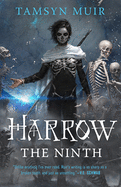
Harrow the Ninth has a tough act to follow in 2019's deranged, electrifyingly fun Gideon the Ninth, but the middle chapter in Tamsyn Muir's Locked Tomb Trilogy is every bit as wild and weird as its delightful predecessor. Following the events of the first book, Muir shifts focus to the necromancer Harrowhark as she joins a cohort dedicated to assisting the godlike Emperor in fighting strange cosmic entities.
Muir has not lost her penchant for throwing readers in the deep end, and some incomprehension is to be expected on their part. In fact, Harrow the Ninth seems purposefully disorienting for fans of the first book: the novel bounces back and forth in time, retelling events from the first book with noticeable differences that grow more glaring over time. Whereas Gideon the Ninth welded the structure of a locked-room mystery to its saga of necromancers and their sword-wielding escorts in an ancient, crumbling space-tomb, Harrow the Ninth plunges confidently into a mind-bending puzzle box structure. There is plenty of satisfaction in piecing things together, but it's not just an exercise in cleverness: Muir has much to say about denial and the dangers of suppressing grief, building to an emotional conclusion that will melt the hardest of hearts.
Harrow the Ninth carries over all the strengths of its predecessor, including the verbal sparring and ever-entertaining insults: "you bursting organ, you wretched, self-regarding hypochondriac and half-fermented corpse with the nails still on." And it delves even deeper into the vulnerabilities of Muir's damaged characters. Few books can be this funny, sad and romantic all at the same time. --Hank Stephenson, manuscript reader, the Sun magazine

